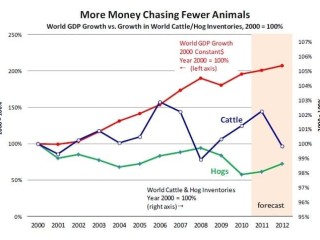 A recent US article in the US Wall Street Journal carried the headline, “Meat Prices Continue their Bull Run” and an opening sentence that was just as thought-provoking.
A recent US article in the US Wall Street Journal carried the headline, “Meat Prices Continue their Bull Run” and an opening sentence that was just as thought-provoking.
It stated: “Here's food for thought: Despite being fed a steady diet of conflicting news about the global economy, consumers around the world are still tucking into pricey steaks and juicy pork chops with gusto.”
The article attracted the attention of Chicago Mercantile Exchange analysts Steve Meyer and Len Steiner.
Commenting in their CME Daily Livestock report this morning, Mr Meyer said it was a sentiment heard many times recently as people tried to reconcile all the economic gloom-and-doom talk with the reality of higher prices at the retail store or on the restaurant menu.
“How can you charge this kind of money for steaks or pork chops, the thinking goes, when 9pc of people in the US don’t have jobs and there is all this fear and panic around?” consumers were asking.
“Well, it often helps to take a step back and look at the world around you,” Mr Meyer said.
“And not just at your town, your state or even your country. Rather, it helps to look at the global perspective.”
New York Times columnist Thomas Friedman wrote a book some years ago titled “The World Is Flat”, arguing that many of the political and physical barriers keeping people apart had been erased, creating a more level playing-field, and consequently a much more competitive environment. The worker in Bangalore or Shanghai now had access not just to the internet or Hollywood movies, but also to the food resources that consumers in developed economies took for granted.
Mr Meyer asked readers to consider both supplies and demand at a global level. In his chart, reproduced here (click on image below for a clearer view), he illustrates what has happened to world cattle and pig inventories since 2000. The world pig inventory by 2010 was down 2pc compared to 2000, and it is expected to grow only modestly in 2011 and 2012.
USDA currently forecasts the total world pig inventory in 2012 at 781.5 million head, 0.2pc lower than in year 2000. The world cattle inventory in year 2012 is forecast at 1.018 billion head, 1.4pc less than what it was in year 2000. Productivity increases have allowed producers to extract a little more beef and pork out of smaller herds but the reality is that in 2012 there are fewer animals than 12 years ago.
Now consider the global demand side of the equation. Since 2000, Mr Meyer points out that the world gross domestic product (GDP) has gone from $32.2 trillion (constant year 2000 dollars) to $63 trillion in year 2010. Forecasts are for 2.7pc world GDP growth in 2011 and another 3pc growth in 2012.
So by year 2012, the world GDP could be as high as $66.7 trillion, more than double what it was a decade ago.
Also important to consider, and contributing to the growth in economic activity, is population growth. The world population increased from about 6 billion people in year 2000 to about 7 billion people today. That is an almost 17pc increase in the number of humans to be fed while again, world cattle and hog inventories have declined.
The increase in population and economic activity has come from areas that are starting with a deficit in the number of calories consumed each day – particularly from meat protein. As incomes increase, people tend to increase protein calorific intake in their diets.
“Again, it is not a matter of munching on ‘pricey steaks or juicy pork chops’, although that happens too,” Mr Meyer argues.
“Rather, it is the small increase at the margins, spread-out over a larger population that has double the money to spend, which is pushing prices higher. It is a flat world that will only get flatter, and more competitive.”
On a per capita basis, the supply of beef, pork and poultry available to US consumers in year 2012 will be the smallest since 1987. Back then, the US economic activity was estimated at $4.6 trillion, compared to $14.5 trillion in 2010.
Food for thought, indeed.
